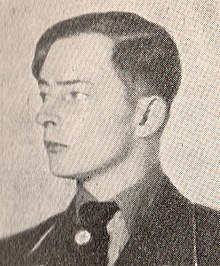Benno von Arent (architect)
Benno von Arent (born June 19, 1898 in Görlitz , † October 14, 1956 in Bonn ; full name: Benno Georg Eduard Wilhelm Joachim von Arent ) was a German architect and set designer during the National Socialist era .
Life
Arent was the son of the Prussian lieutenant colonel Benno von Arent (1868-1904) and grandson of the Prussian lieutenant general Benno von Arent . After graduating from high school, Arent was a participant in the First World War and then active in Freikorps associations and the Reichswehr . After the First World War, Arent became an apprentice in a gas knife and fittings factory and then a costume designer at an equipment company. During the period of high unemployment he worked, among other things, as a car salesman and, on the side, learned the profession of an architect as an autodidact .
From 1923 he was an outfitter on various Berlin theaters, initially without success. Politically, he was a member of the völkisch -minded, anti-Semitic Kampfbund für deutsche Kultur , in 1931 he joined the SS and in 1932 the NSDAP (membership number 1.105.236). In 1932 von Arent was the founder of the “Association of National Socialist Stage and Film Artists”, which in 1933 was renamed “ Comradeship of German Artists ”. After the takeover of the NSDAP arent belonged to the board of the Ministry of Arts at. In addition to his work as a set designer, especially for the German Opera House, which is subordinate to Goebbels (the former Städtische Oper Berlin), he also designed medals and uniforms and he furnished political events.
After personal assignments for Adolf Hitler , Arent was appointed Reich stage designer (popularly: "Reibübi") in 1936, a title that was primarily intended to underline Arent's exemplary position as a stage designer and set designer for NS-compliant theater performances. Hitler occasionally forced his own stage designs on him in a kind of teacher-student relationship, a relationship that helped to establish the career of the Reich set designer. In 1942, in a conversation at the table, Hitler referred to him as one of the three most important stage designers, but although he was able to launch Arent on various stages, he did not succeed in getting him a place at the Bayreuth Festival. Arent, whose artistic views were shared and probably also influenced by Hitler, preferred a realistic, often monumental style for his own stage sets and costumes, which he tried to give mass effects through popularity and comprehensibility. When the war broke out, however, he was unable to develop or even enforce his own style in view of the artistically more significant competition.
His job as the designer of the festival streets at major marches also had an impact on his stage style, including the staging of the Meistersinger party congress . In 1936 Arent was appointed to supervise the set designers and the Presidential Council of the Reich Theater Chamber. On April 20, 1937, like many leading Nazi cultural officials, he received the title of professor . In parallel to his party-related duties, von Arent continued to work as an architect. His best-known work was the design of the "Berlin House of the German Labor Front (DAF) ". In the spring of 1939, von Arent was appointed "Reich Commissioner for Fashion", an office that was closed after a short time due to the war.
During the war against the Soviet Union in World War II , Arent, who had already joined the SS in 1931, was part of Heinrich Himmler's staff . On August 15, 1941, according to his notes, he was an eyewitness to a war crime near Minsk in which partisans and Jews were murdered. In 1944 Arent was also appointed a member of the Waffen SS and SS Oberführer. At the end of the war he was taken prisoner by the Soviets , from which he was released in 1953. In the meantime, his work A Sudeten German Diary (1939) was placed on the list of literature to be sorted out in the Soviet occupation zone . In 1956 in Berlin a denazification proceedings intently, shortly after his sentencing died arent.
Filmography (selection)
- 1924: The most beautiful woman in the world
- 1933: laughing heirs
- 1933: Hitler Youth Quex: A film about the spirit of sacrifice among German youth
- 1933: Love must be understood
- 1934: The island
- 1935: an ideal husband
- 1938: The stars shine
literature
- Ernst Klee : The cultural lexicon for the Third Reich. Who was what before and after 1945. S. Fischer, Frankfurt am Main 2007, ISBN 978-3-10-039326-5 , p. 19.
- Benno von Arent , in: Internationales Biographisches Archiv 50/1956 of December 3, 1956, in the Munzinger archive ( beginning of article freely available)
- Sebastian Werr: Heroic worldview. Hitler and the music . Boehlau, Vienna 2014, pp. 172–175.
Web links
- Literature by and about Benno von Arent in the catalog of the German National Library
- Benno von Arent in the Internet Movie Database (English)
Individual evidence
- ^ List of literature to be sorted out at polunbi.de
| personal data | |
|---|---|
| SURNAME | Arent, Benno from |
| ALTERNATIVE NAMES | Arent, Benno Georg Eduard Wilhelm Joachim von (full name) |
| BRIEF DESCRIPTION | German architect, "Reich set designer" in the Third Reich |
| DATE OF BIRTH | June 19, 1898 |
| PLACE OF BIRTH | Goerlitz |
| DATE OF DEATH | October 14, 1956 |
| Place of death | Bonn |
